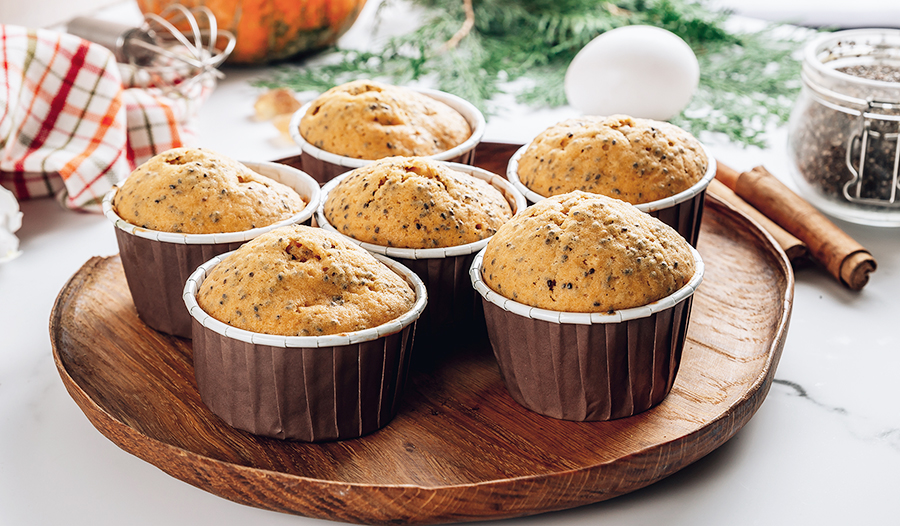7 Ways to Replace Eggs in Cooking and Baking

When it comes to baked goods, eggs are typically a staple ingredient that is needed. But let’s say you don’t eat eggs, have an egg allergy, or you’ve forgotten to purchase them at the store. What do you do!?
There are many reasons why you might be looking to substitute eggs. Egg allergies are one of the top eight most common food allergies. Most children who are allergic to eggs may be able to tolerate eggs over time, but some will remain allergic for their entire lives. Some people avoid eggs due to dietary preferences such as veganism—when one elects to abstain from any animal products, including eggs. If you are choosing to not use eggs for whatever reason, you’re in luck! There are many ingredients you could use instead of eggs in baking.
The Role of Eggs in Baking
In baking, eggs are used for many different purposes. They have an impact on the structure, color, flavor, and consistency of baked goods by adding the following chemical reactions.
- Moisture: The liquid part of eggs is absorbed into the other ingredients which add moisture to the finished product. In egg replacement, this moisture can come from a source such as water.
- Binding: Eggs help hold ingredients together due to their texture, preventing baked goods from falling apart. In egg replacements, binding can come from many different sources, which you will see below in the examples.
- Leavening: Eggs trap pockets of air in foods, causing them to expand during heating. This gives baked goods their volume as well as a light, airy texture. This can be seen when using an egg replacement like aquafaba.
- Appearance: Eggs brown when exposed to heat which gives baked goods a brown color.
7 Ways To Replace Eggs In Baking
These examples are great for the replacement of one egg. For the best results substitute four or fewer eggs; any more than that may cause an undesirable taste or texture.
How to Make a Flax Egg
Flax eggs are one of the most popular options when replacing eggs in baking. Flax seeds are a great source of omega-3 fatty acids and protein.
To replace one egg using a flax egg, mix together 1 tablespoon of ground flaxseed with 2 ½ tablespoons of water and let sit for roughly 5 minutes. You can buy ground up flax seeds or grind them up yourself using whole flax seeds. This replacement may make baked goods heavy and dense. It works best in pancakes, waffles, muffins, bread, and cookies.
How to Make a Chia Egg
Chia eggs aren’t quite as popular as a flax egg but work nearly the same way with a very similar nutrient benefit. Compared to flax seeds, chia contains more magnesium, phosphorus, and selenium per serving. To replace one egg using a chia egg, mix together 1 tablespoon of chia seeds with 2 ½ tablespoons of water and let sit for roughly 5 minutes. This replacement may also make baked goods heavy and dense. Like flax eggs, it works best in pancakes, waffles, muffins, bread, and cookies.
Banana Egg Replacement
Bananas as an egg replacement are great if you like the taste. Using this replacement will give the finished product a slight banana flavor. Bananas are also a great source of potassium, vitamin B6, and vitamin C. Other puréed fruits like pumpkin and avocado will work just as well with less flavor change. One egg equals ½ medium mashed banana. This works best with cakes, muffins, brownies, and quick bread.
Applesauce Egg Replacement
Did you know that apples are one of the highest fruit sources of antioxidants? The same goes for applesauce. Choosing an unsweetened variety is the best for baking. If you choose flavored applesauce, it may have added sugar. If it does have added sugar, you will need to adjust the amount of sugar you add as an ingredient. To replace one egg using applesauce, ¼ cup applesauce equals one egg.
Silken Tofu Egg Replacement
Tofu is a great option because it has a neutral flavor and is high in protein. There are many different types of tofu. Silken tofu is best for baking as it has higher water content. The more water that is pressed out, the more firm the tofu gets. To use as an egg replacement in baking, one egg equals ¼ cup silken tofu. This is best used in brownies, cookies, quick bread, and cakes.
Aquafaba Egg Replacement
This is the liquid leftover from cooking beans or legumes—the same liquid that you pour out of a can of chickpeas. Aquafaba is a great replacement for egg white as it has a very similar consistency. The only downfall with using aquafaba as an egg replacement is the prep work. These require some beating until they are white and foaming with stiff peaks. Using cream of tartar is a great trick to help stiffen the “whites.” One egg equals 3 tablespoons of aquafaba.
Commercial Egg Replacement
These egg replacements come in a variety of different brands and are typically made using potato starch, tapioca starch, and leavening agents. To replace one egg will depend on the brand so be sure to read the packaging. Most call for 1 ½ teaspoons of powder with 2–3 tablespoons) of warm water per egg. These can be used in any form of baking.
Health Benefits of Egg-Free Cooking
Cooking without eggs can be great for your health, especially for those with heart-related diseases. Each egg contains 187mg of cholesterol. For heart health, it’s recommended that consumers stay below 200mg of cholesterol each day. Egg replacements such as flax seeds and chia seeds contain heart-healthy fats like omega-3s and fiber which can help improve one’s overall heart health.
Cost Factors When Replacing Eggs
The cost of an item has a great impact on the choices we make. Let’s take a look at the breakdown of a flax egg replacement and a conventional chicken egg. A 16-ounce jar of ground up flax seeds is enough to make about 60 egg replacements. The cost of a 16-oz bag of ground flax seeds is roughly $5.59, or $.09 per serving. A 12-count container of eggs costs roughly $1.18 (popular nationwide chain) or $.09 each. Using a flax egg and chicken egg is roughly equivalent in price. Although price does not have too much of an impact, there are still many other factors that influence the choice of using egg replacements.
Environmental Impact of Eggs
Egg production, like other commercial farms, can create negative effects on the environment. These can be seen in the emission of greenhouse gases and the contamination of soil and water. Hen houses have poor air quality and emit ammonia and dust into the air. Adding hen manure to farmland can lead to nutrient runoff into water bodies and may runoff in rainfall as well. Egg replacements don’t generally have a negative impact on the environment.
Summary
Overall, there are many different types of egg replacements to make baking without eggs an easy process. Not only do allergies impact the choice of using eggs, but many other factors including, dietary preferences, health implications, costs, environmental impacts, and animal welfare. Baking can be fun and exciting. Knowing how to replace eggs in baking keeps can keep you doing something you love without sacrificing taste or texture.
References:
- Davis, B., & Melina, V. (2014). Becoming vegan: The complete reference to plant-based nutrition. Summertown, TN.: Book Publishing Company.
- Xin, H., Gates, R., Green, A., Mitloehner, F., Moore, P., & Wathes, C. (2019, December 11). Environmental impacts and sustainability of egg production systems. Retrieved October 27, 2020, from https://www.sciencedirect.com/science/article/pii/S0032579119320863?via=ihub9i
DISCLAIMER:This Wellness Hub does not intend to provide diagnosis...













































































 Table of Contents
Table of Contents


